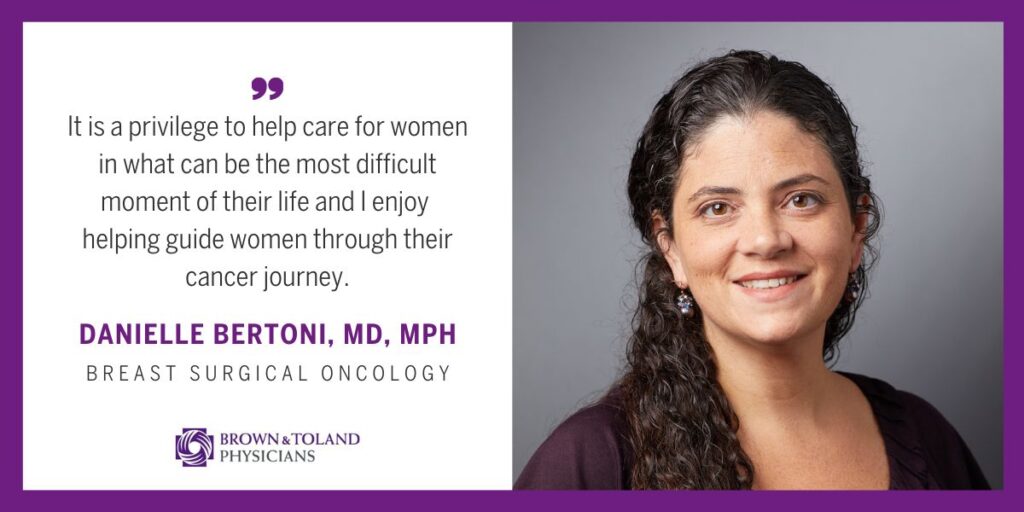Q&A with Dr. Danielle Bertoni, Breast Surgical Oncologist

Danielle Bertoni, MD, MPH, is a breast surgeon at BASS Cancer Center in Walnut Creek who specializes in breast surgical oncology.
Dr. Bertoni believes in making the patient the central focus of a team of doctors, nurses, social workers and other providers. Highly personalized care is important, she says, adding that she considers not only the patient’s diagnosis, but also their personal values and beliefs while guiding them through the process. “I take ownership of my patients,” she says. “This is a long-term relationship.” We sat down with Dr. Bertoni recently to discuss the latest breakthroughs in breast cancer treatment.
Q: Why did you decide to become a physician, and how did you choose breast oncology and surgery?
A: I wanted to become a physician since age 9. My mother was a medical secretary for a hepatologist, and I occasionally went to work with her. Her office was in the hospital, and I always just felt comfortable there and intrigued by it. I also spent a lot of my life volunteering and was always a natural caregiver. I chose breast surgical oncology for many reasons. I have a personal connection because my mother, my grandmother, my aunt and my cousin all had breast cancer. I was drawn toward oncology at a young age, and I was also drawn toward women’s health. Breast cancer is not only the most common cancer affecting women, but it also has the best prognosis. Most breast cancers are treatable and curable. It is a privilege to help care for women in what can be the most difficult moment of their life and I enjoy helping guide women through their cancer journey.
Q: Can you provide guidance on breast cancer screening – when to start, how often to screen and important risk factors?
A: There is a lot of different information and guidelines out there about when to start mammograms and how often to have them. The NCCN (National Comprehensive Cancer Network), which is the organization that issues cancer care, treatment and screening guidelines for all cancers, recommends getting screened by your health care provider at age 25 to make sure you are not a high-risk patient who needs early screening. If not, then they recommend starting at age 40 and continuing annually.
I agree with these recommendations. There is some disagreement between medical experts about the right age to start and how often to do mammograms. This primarily comes from looking at a cost benefit analysis to society. There is also some concern that we are finding early cancers that do not need treatment, so we are “overtreating” breast cancer and breast disease. However, the benefit of starting mammograms sooner is that cancer is most treatable with less invasive or less intense treatment when it’s caught early. In terms of risk factors, they include family history of breast or ovarian cancer, a family member who had breast cancer before the age of 50, genetic mutation in patient or family member, breast mass, nipple changes, skin changes and nipple discharge. These are all reasons to get evaluated by your physician and potentially get some type of breast imaging.
Q: Is there a role for genetic testing in the early detection of breast cancer?
A: There is a role for genetic testing to help identify women who are at an increased risk of getting breast cancer. Women who have a significant family history of breast and/or ovarian cancer, pancreatic cancer, colon cancer, melanoma, multiple cancers or cancers in family members at young ages or are of Ashkenazi Jewish heritage should ask their providers if they are a candidate for genetic testing.
It is important to make sure they get panel testing, which typically includes more than 40 genetic mutations. Most companies who do genetic testing will offer out-of-pocket testing (meaning you pay for it without insurance) for $249. Some insurance will cover the cost if you meet criteria based on the NCCN guidelines. Genetic testing is important if you are at risk of having a mutation based on your personal or family history. If you have a genetic mutation that is associated with one or more cancers, it allows us to screen you and focus on cancer prevention. There is a special high-risk surveillance protocol for breast cancer in patients who have certain genetic mutations. There is also protocol and recommendations for high-risk screening for colon cancer, melanoma, pancreatic cancer and many more if you have a mutation that puts you at risk for these cancers. It allows us to screen you better, so that if you do develop a cancer, we can catch it much earlier and you can have less invasive treatment. There are also some other recommendations for prevention and risk reduction that we can discuss with you if you have a genetic mutation.
Q: What are the surgical options for women diagnosed with breast cancer?
A: Surgery for the treatment of breast cancer provides local regional control of the cancer. It does not prevent distant or metastatic spread of cancer. The other treatment we offer for local control is radiation. For local control of breast cancer, we offer breast conserving treatment and mastectomy. Breast conserving treatment consist of a lumpectomy/partial mastectomy (which is removing the tumor with a small rim of normal tissue around it) followed by postoperative radiation to the breast. Mastectomy is removing the entire breast. Some patients still require radiation after mastectomy. This is called post mastectomy radiation. Lumpectomy with postoperative radiation is considered equally effective cancer treatment to mastectomy. With mastectomy we cannot remove 100 percent of the breast tissue so there is still a 1-3 percent risk of local recurrence. With lumpectomy followed by radiation the risk is essentially the same.
There are some women (over age 65) who do not need radiation after lumpectomy. There are some women, who need radiation even after a mastectomy.
There are many more surgical options that I could discuss in more detail. For example, we can do nipple sparing mastectomy (you keep your nipple even when we remove the breast tissue) or non-nipple sparing mastectomy. When you do a mastectomy, you can go flat, you can have an implant to replace the tissue we remove, or you can have a flap (when they take your tummy tissue or other tissue to create a new breast). With a lumpectomy/partial mastectomy, you can also do reconstruction in the form of a breast lift and/or reduction in the cancer breast and the opposite breast for symmetry. This is often called oncoplastic reconstruction. These different types of reconstruction (oncoplastic, implants, flaps) are done by plastic/reconstructive surgeons and this is covered by insurance per federal law.
Also, part of the surgical treatment for breast cancer, is what we refer to as nodal staging. For invasive breast cancer, we need to remove some lymph nodes in the armpit to make sure cancer has not spread outside of the breast. The procedure we do to check the lymph nodes is called a sentinel lymph node biopsy. This involves injecting a dye into the breast to identify the sentinel lymph nodes, which are the key lymph nodes for the breast, and removing the sentinel lymph nodes — typically 2-3 lymph nodes are removed. Again, some women are able to avoid this procedure. There are so many options and this is a very nuanced decision that requires in-depth conversation with your surgical oncologist to help you decide which option is best for you. In part, this decision is based on information about your cancer and in part this is a personal decision and is different for each patient. I passionately believe in a personalized tailored approach to breast cancer treatment. There is not necessarily a one-size-fits -all answer.
Q. What do you consider to be the most exciting new developments in the field of breast cancer, particularly surgical treatments?
A: There are many exciting developments in our field. Breast cancer is possibly the most researched field in medicine, which means we make rapid advancements in treatment. Our primary focus has been on improving our systemic treatments and “de-escalation” of treatment. Another hot topic has been timeliness of care. Systemic treatments are medications given by a medical oncologist to treat or prevent distant or metastatic disease — when disease spreads to other parts of the body outside the breast and lymph nodes. We have come a long way with new medicines (anti-Her2, immunotherapy, CDK4/6 inhibitors) to treat breast cancer. We have also been focusing on “de-escalation” or not overtreating breast cancer. We have had some recent database reviews with large numbers showing that breast conservation (lumpectomy with radiation) may have better survival than mastectomy (removal of entire breast). We are using advanced testing (Oncotype and MammaPrint) to help us better identify which patient will benefit from chemotherapy, so we are not giving chemotherapy to patients who do not benefit. We have results from research studies that show shorter courses of radiation, three and four weeks, are just as effective as the traditional six-week courses and are now starting to get results from European studies regarding five-day courses. We are finding that some patients do just as well with no sentinel lymph node surgery. Some women do quite well with no radiation or radiation only to the area where the cancer is (partial breast irradiation). We are constantly asking, is there a better way to do this? can we get the same cancer outcome or similar with less harm or toxicity to our patients?
In terms of timeliness of care, there have been some national accrediting bodies (the Commission on Cancer, or COC) that are looking at time between diagnosis and surgery or first treatment. They are finding that delaying treatment affects overall survival. There are several studies that looked back at this and have shown this. The COC has responded by adding as one of their benchmarks/criteria as treatment should be no more than 60 days from diagnosis. I am personally very passionate about getting patients seen and to surgery as quickly as possible when they have a new cancer diagnosis. In part, because of this data that we know survival is impacted at 60 days, but also because I know the psychologic impact it has on a patient to have a cancer sitting in their breast untreated.
We are also talking a lot at our national meetings about survivorship and long term effects of cancer treatments on patients. It is truly an exciting field!

MEDICAL DISCLAIMER: The content of this Website or Blog is not intended to be a substitute for professional medical advice, diagnosis, or treatment. Always seek the advice of your physician or other qualified health provider with any questions you may have regarding a medical condition. Never disregard professional medical advice or delay in seeking it because of something you have read on this Website or Blog.
If you think you may have a medical emergency, call 911 immediately, call your doctor, or go to the emergency room/urgent care.
